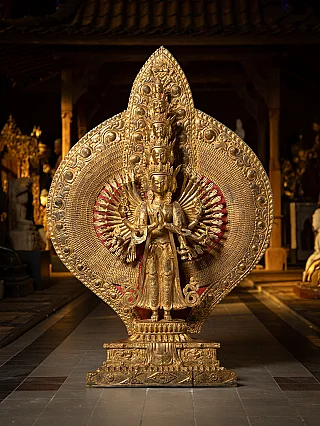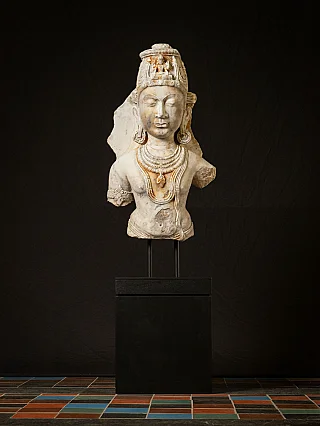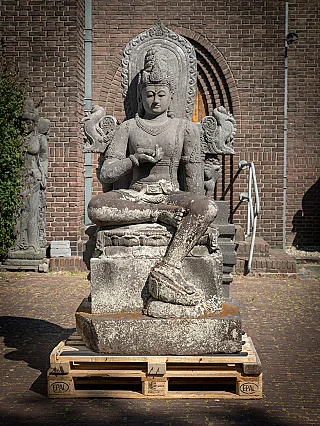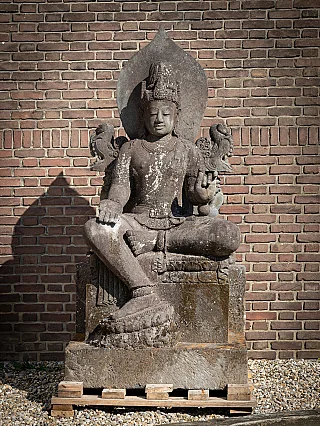Avaloketishvara
Author : Peter Vredeveld

Avaloketishvara with the thousand arms / hands is one of the most known bodhisattvas.
In the vast realm of Mahayana Buddhism, Avalokiteshvara emerges as a beacon of compassion, a celestial figure celebrated across diverse cultures. This intricate exploration embarks on an odyssey through the layers of Avalokiteshvara's essence, unraveling the origins, various interpretations, and the profound symbolism encapsulated in the Thousand Arms manifestation.
Essence of Avalokiteshvara

Avalokiteshvara, the compassionate Bodhisattva, embodies the very essence of Karuna—a boundless commitment to alleviating the suffering of all sentient beings. As we embark on this journey, envision Avalokiteshvara's form, standing as the earthly manifestation of the eternal Amitabha Buddha. His compassionate gaze spans the cosmos as he guards and protects the world during pivotal transitions, such as the departure of Lord Buddha and the anticipated appearance of the future Buddha, Maitreya.
Interpretations of Avalokiteshvara:
The name "Avalokiteshvara" is not a mere label but a doorway to myriad interpretations. It resonates as "the lord who looks in every direction," reflecting his all-encompassing compassion. Yet, as we traverse cultural landscapes, his name transforms—becoming "Spyan-ras gzigs" in the lofty terrains of Tibet, "Nidü-ber üjegi" echoing in the vast Mongolian steppes, and "Lokeshvara," reverberating through the temples of Indochina and Thailand.
Origin in Mahayana Buddhism
Within the embrace of Mahayana Buddhism, Avalokiteshvara emerges as a central figure—a Bodhisattva of profound significance. Dive into the core teachings as Avalokiteshvara, with unwavering resolve, vows to assist those in the throes of adversity. A pivotal decision unfolds as he postpones his own Buddhahood, choosing the arduous path of the Bodhisattva for the sake of sentient beings. The Mahayana Sutras, sacred scriptures revered in the Mahayana tradition, unfold a tapestry of wisdom surrounding Avalokiteshvara.
The Lotus Sutra (Saddharma Pundarika Sutra):
Amidst the vast literature of Mahayana Buddhism, The Lotus Sutra emerges as a treasure trove of teachings. Avalokiteshvara takes center stage within its verses—a compassionate Bodhisattva, depicted with profound care for sentient beings.
Tibetan Tradition
Avalokiteshvara's narrative takes on hues of mysticism and devotion in the highlands of Tibetan tradition. Delve into tales that weave dual origins—one from the heart of a compassionate monk and the other as the universal manifestation of the compassion of all Buddhas. Each story, a brushstroke on the canvas of Tibetan spirituality, adds layers to Avalokiteshvara's celestial portrait.
Thousand Arms Avalokiteshvara
As we stand on the precipice of profound transformation, Avalokiteshvara's vow reverberates: "Should He Ever become disheartened in saving sentient beings, may his body shatter into a thousand pieces." Witness the symbolic metamorphosis as Avalokiteshvara becomes the Thousand Arms Bodhisattva—a visual symphony of overwhelming compassion and unwavering determination.
Symbolism and Miraculous Transformation:
Marvel at the symbolism encapsulated in Avalokiteshvara's Thousand Arms and Heads. Amitabha Buddha, witness to the Bodhisattva's unwavering commitment, grants a divine intervention. Eleven shattered heads are replaced, not merely for aesthetics but as instruments to hear the cries and pleas of suffering beings. Thousand-fold arms unfold, not as a display of power but as a manifestation of compassion—reaching out to touch, heal, and uplift.
Mantras for Spiritual Connection
In the sacred realm of spiritual practice, mantras serve as resonant chords connecting devotees with the divine. Here, we explore the melodic nuances of mantras associated with Avalokiteshvara, each a celestial invocation fostering a profound connection.
Notable Mantras:
- O Mai Padme H:
Within the cadence of this six-syllable mantra, Avalokiteshvara's compassion echoes through the chambers of Tibetan monasteries, a harmonious call to enlightenment.
- Nama Saptn Samyaksabuddha Kon Tadyath o cale cule cunde svh:
In the intricate brushstrokes of Shingon Buddhism, practitioners intone this mantra, unlocking layers of mystical significance.
- On Arurikya Sowaka:
The resonance of this mantra within the Shingon tradition unfolds like a sacred dance, each syllable invoking Avalokiteshvara's benevolent presence.
- Namah Srimadavalokitesvaraya:
Across the serene landscapes of Himal Pradesh, India, devotees chant this mantra, seeking solace in the compassionate embrace of Avalokiteshvara.
Conclusion
As the odyssey through Avalokiteshvara's story concludes, the profound resonance of compassion and unwavering commitment lingers. In his compassionate gaze and Thousand Arms, we find not just a celestial being but an enduring symbol—a guiding light along the Bodhisattva path. As practitioners engage with the manifold facets of Avalokiteshvara's story, they find inspiration, solace, and the transformative power to tread the compassionate journey of the Bodhisattva.
People Also Ask / Frequently Asked Questions (FAQs)
- Who was Avalokiteshvara in Buddhism?
Avalokiteshvara is a prominent Bodhisattva in Mahayana Buddhism, particularly in Tibetan Buddhism and East Asian Buddhist traditions. Bodhisattvas are enlightened beings who have chosen to remain in the cycle of birth and death (samsara) to help all sentient beings achieve enlightenment. Avalokiteshvara is often associated with compassion and is considered the embodiment of the compassion of all Buddhas.
- Is Avalokiteshvara a Hindu?
Avalokiteshvara is not a Hindu deity. While Hinduism and Buddhism share historical and cultural roots, Avalokiteshvara is a figure specifically revered within Buddhist traditions.
- Is Avalokiteshvara a God?
Avalokiteshvara is considered a Bodhisattva, not a god, in Buddhist cosmology. Bodhisattvas are beings who have attained enlightenment but have chosen to remain in the cycle of birth and death to help others achieve enlightenment. They are revered for their compassion, wisdom, and commitment to the well-being of all sentient beings.
- Is Avalokiteshvara the same as Shiva?
No, Avalokiteshvara and Shiva are not the same. Shiva is a prominent deity in Hinduism, known as the god of destruction and regeneration. Avalokiteshvara, on the other hand, is a Bodhisattva in Buddhism, associated with compassion. While there may be some cultural and historical interactions between Hinduism and Buddhism, these two figures belong to distinct religious traditions.
Share this page




















